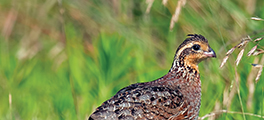
Northern Bobwhite
Diminished in number, the bird with the distinctive call is making a comeback
By Susan Campbell
For those fortunate enough to live in open piney woods or adjacent to large farm fields, the whistled call of the bobwhite quail may be a familiar sound. But, as with so many of our bird species, this once prolific songster has diminished in the Piedmont. And anyone in search of winter partridge for the table is increasingly likely to be disappointed.
Bobwhite quail measure between 8 to 11 inches beak-to-tail and have very cryptic brown, black and white markings that make them all but impossible to see in the grassy habitats they call home. The male has a bright, white eye-stripe and throat marking, and is the one who announces his territory through a repeated “bob-white” call. The female is not only smaller but drabber, with an eye-stripe and throat that are a buffy color. This stout bird’s short sharp bill, strong legs and feet with sharp claws, make it well adapted to foraging at ground level for insects, berries and soft vegetation.
Northern bobwhite males attract a mate using their loud repetitive calls in the spring. The female will reply with a four-syllable whistle of her own. Following breeding, the pair creates a domed nest concealed in tall grasses, and the hen lays up to 20 pure white eggs. It takes about 25 days of incubation for the young to hatch. Hens will renest if the eggs are eaten or destroyed. Upon hatching, the chicks will immediately follow their parents, learning how to hunt bugs and which shoots are the most nutritious. As a group they are referred to as a covey. They will stay together through the winter and may join other families to form coveys of thirty or more birds. When alarmed at an early age, the young will scatter and freeze to avoid predators. Once they can fly, they will take to the air in a loud blur of wings if they are startled by a potential predator.
Quail were a very popular game bird throughout North Carolina until not that long ago. Since the 1980s, when their numbers began to decline, they’ve been much harder to find. A combination of factors is believed to be responsible. Not only have open woodlands and agricultural fields with hedgerows become more scarce but ground predators such as foxes, coyotes, raccoons and free roaming cats have increased. Also, the timing of rainfall can significantly affect breeding productivity. Too much rain too early may inundate nests and dry conditions when chicks hatch may result in insufficient food.
These days, hunters search for coveys in the forests and fields that comprise the patchwork of Game Lands in our portion of the state or they go to private game reserves. Their pursuit requires a well-trained bird dog and a good deal of patience. However, active quail management is occurring locally. Two strategies are at work: opening up forested habitat using prescribed burning and replanting undesirable vegetation with quality cover. Recent efforts by biologists with the N.C. Wildlife Resources Commission and at Fort Bragg (along with assistance from local Quail Unlimited chapters) are resulting in gradual increases in northern bobwhite. We certainly hope this trend continues so that in the not too distant future, sightings of winter coveys will be once again commonplace throughout central North Carolina and the song of the bobwhite will return to the South. OH
Susan would love to receive your wildlife observations and photographs at susan@ncaves.com.





